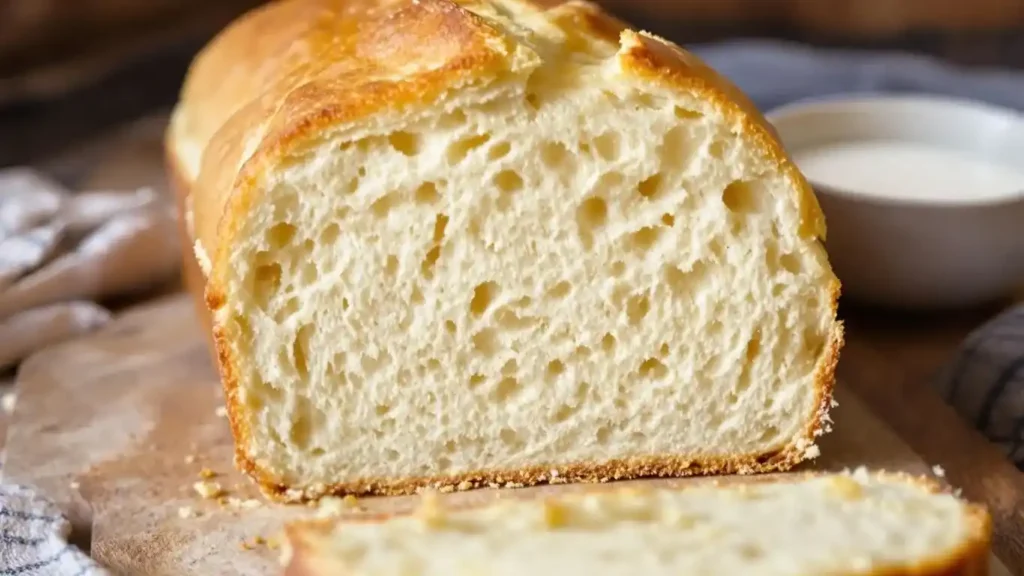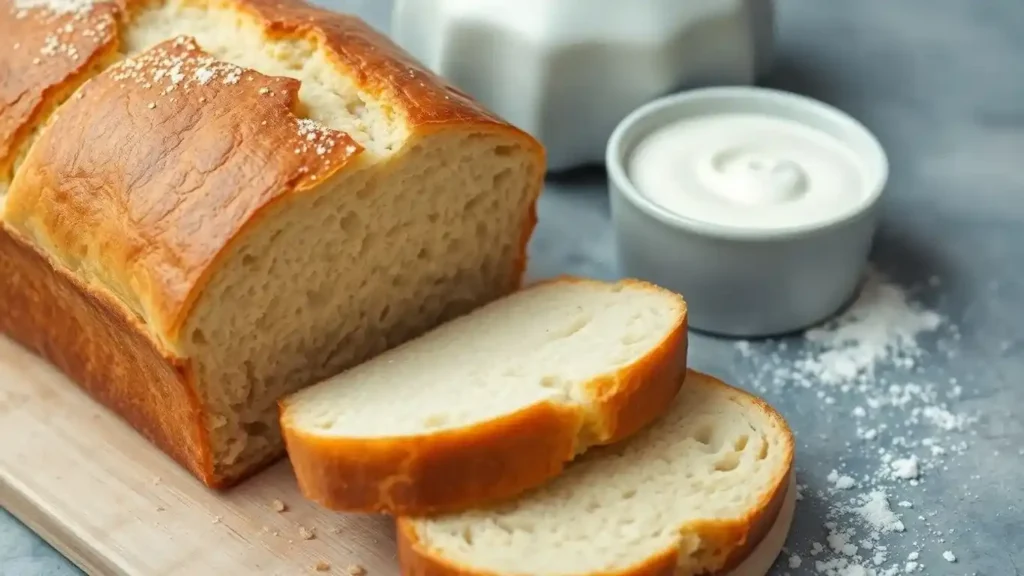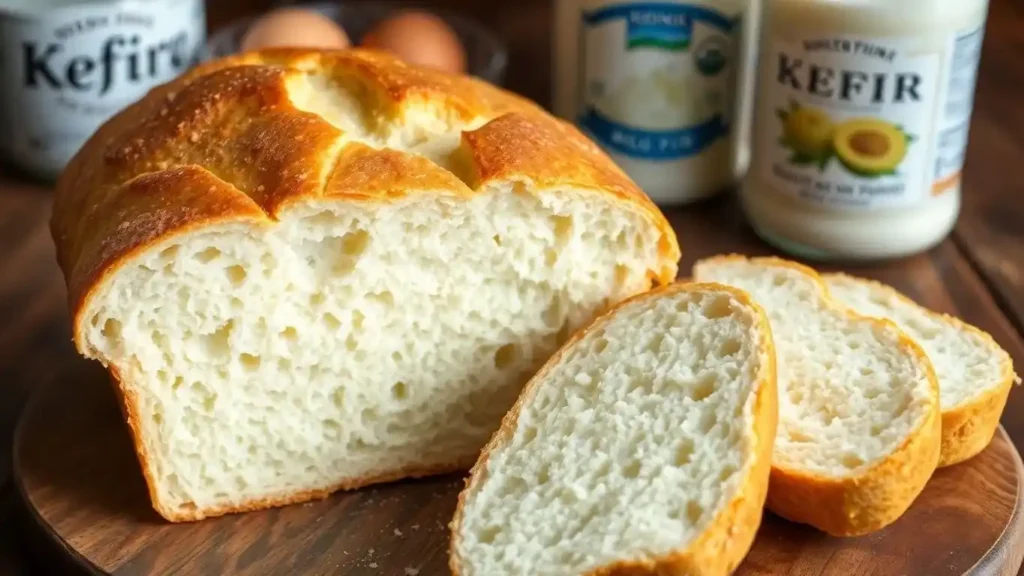Kefir is more than just a probiotic-packed drink it’s a powerful ingredient in baking that can enhance texture, flavor, and nutritional value. Its tangy taste and creamy consistency make it a versatile substitute for buttermilk, yogurt, and even sour cream in recipes. Whether you’re making fluffy pancakes, tender muffins, or rustic sourdough bread, kefir’s acidity helps activate leavening agents, resulting in light and airy baked goods.
But what makes kefir stand out in baking? How does it compare to traditional dairy ingredients like buttermilk? And can it truly improve the health benefits of your favorite treats? In this guide, we’ll explore the science behind kefir’s baking properties, its nutritional advantages, and practical tips for incorporating it into your recipes. Whether you’re looking for a dairy alternative or a way to boost the gut-friendly benefits of your baked goods, kefir is an ingredient worth experimenting with.
Table of contents
Understanding the Role of Kefir in Baking

How Kefir Enhances Texture and Flavor
Kefir, a fermented dairy product, is a game-changer in the baking world. Its unique tangy flavor and creamy texture can transform ordinary baked goods into something extraordinary. When you use kefir in your recipes, it not only adds moisture but also enhances the overall texture, making cakes and breads softer and more tender. The fermentation process of kefir introduces a subtle sourness, similar to buttermilk, which balances sweet flavors perfectly.
- Adds a tangy flavor similar to buttermilk
- Enhances moisture, making baked goods softer
- Improves crumb structure in cakes and breads
The Science Behind Kefir’s Baking Properties
The magic of kefir in baking lies in its acidity and fermentation. The lactic acid in kefir reacts with baking soda, creating carbon dioxide bubbles that help dough rise. This reaction is particularly useful when baking with wheat flour, as it helps to develop gluten, resulting in a better crumb structure. Additionally, the proteins in kefir contribute to a more robust and elastic dough, which is essential for achieving the perfect rise and texture in your baked goods.
Comparing Kefir to Traditional Baking Ingredients
When you compare kefir to traditional baking staples like milk or buttermilk, there are several advantages. Kefir has a higher protein content than buttermilk, which can add nutritional value to your baked treats. Unlike regular milk, kefir is fermented, which means it contains beneficial probiotics that can aid digestion, even though most of these probiotics don’t survive the baking process.
Here’s a quick comparison:
| Ingredient | Protein Content | Probiotics | Acidity |
|---|---|---|---|
| Milk | Low | None | Low |
| Buttermilk | Moderate | None | High |
| Kefir | High | Yes | High |
Using kefir in baking not only enhances the flavor and texture of your goods but also adds a nutritional boost that can make your treats a bit healthier. Whether you’re making muffins, breads, or even pancakes, kefir is a versatile ingredient that can replace milk or buttermilk seamlessly.
The Nutritional Benefits of Using Kefir in Baking
Protein Content and Its Impact on Baked Goods
Kefir packs quite a punch when it comes to protein, making it a great addition to your baking routine. When you swap out regular milk or buttermilk for kefir, you’re not just adding flavor, but also boosting the protein content of your baked goods. This added protein can help create a more satisfying and nutritious treat, perfect for those looking to add a little extra protein to their diet.
Kefir as a Lactose-Free Alternative
For those who are lactose intolerant, kefir might be a game-changer. Kefir is up to 99% lactose-free, which means you can enjoy the benefits of kefir without the worry of lactose discomfort. This makes it a great alternative to traditional dairy products in baking, allowing more people to enjoy delicious baked goods without compromise.
Vitamins and Minerals Found in Kefir
Kefir is not just about protein and lactose-free benefits. It also brings a variety of vitamins and minerals to the table. Here’s a quick look at what kefir offers:
- Calcium: Essential for strong bones and teeth.
- Potassium: Helps maintain healthy blood pressure levels.
- Magnesium: Important for muscle and nerve function.
- B Vitamins: Including B12 and riboflavin, which are vital for energy production.
Baking with kefir not only enhances the taste and texture of your goods but also infuses them with beneficial bacteria and nutrients. This makes it a wholesome choice for health-conscious bakers.
How Kefir Acts as a Leavening Agent
The Acidic Nature of Kefir and Its Reaction with Baking Soda
Kefir is an amazing ingredient that plays a crucial role in baking, especially when it comes to leavening. Its acidic nature, thanks to lactic acid bacteria and acetic acid bacteria, makes it a perfect partner for baking soda. When these two ingredients mix, they create a reaction that produces carbon dioxide gas, which helps dough rise. This process is similar to using buttermilk or yogurt but with a unique tangy twist.
Using Kefir in Gluten-Free Baking
For those exploring gluten-free baking, kefir offers a fantastic option. Its fermentation process breaks down proteins, making it easier to digest and enhancing the texture of gluten-free breads. Plus, the extra liquid kefir provides can help hydrate gluten-free flours, which often need more moisture.
Replacing Sourdough Starter with Kefir
If you’re out of sourdough starter, kefir can be a handy substitute. The fermentation from kefir mimics the sourdough process, giving your bread a similar tang and texture. Just mix kefir with your flour and let it sit, allowing the bacteria to work their magic.
Using kefir as a leavening agent not only brings a delightful taste to your baked goods but also offers a probiotic boost, making your treats not just delicious but also beneficial for your gut health.
Creative Ways to Incorporate Kefir into Your Baking

Substituting Kefir for Buttermilk in Recipes
Kefir is a fantastic alternative to buttermilk in your baking adventures. It shares a similar tangy flavor profile, making it perfect for pancakes, muffins, and even fried chicken. Kefir can add a unique twist to your usual recipes, providing a richer taste and texture. Next time you’re whipping up a batch of pancakes, try swapping out the buttermilk for a bit of kefir—it might just become your new favorite ingredient.
Using Kefir in Pancakes and Waffles
Adding kefir to your pancake or waffle batter results in a delightful, fluffy texture. The acidity in kefir reacts with baking soda, giving your breakfast treats a light and airy finish. Consider using whole milk kefir for added richness without needing extra butter or oil. This small adjustment can make a big difference in the taste and feel of your morning meal.
Exploring Savory and Sweet Kefir Recipes
Kefir isn’t just for sweet treats; it can also enhance savory dishes. Imagine a savory veggie waffle or a tangy kefir-infused bread. For a sweet twist, you can make a farmer cheese and peach crostata using kefir. The possibilities are endless, and experimenting with kefir in both sweet and savory recipes can lead to some delicious discoveries.
Kefir’s versatility in baking is like having a secret weapon in the kitchen. Whether you’re aiming for a tender crumb in your muffins or a tangy kick in your savory dishes, kefir’s got you covered. Its probiotic properties and dairy richness add depth and character to every bite.
Tips for Baking with Kefir
Choosing the Right Type of Kefir for Your Recipe
When it comes to baking with kefir, selecting the right type is key. You can choose between plain, flavored, or even low-fat varieties. Plain kefir is often the best choice for savory breads and biscuits, while flavored kefir can add an interesting twist to sweet treats. Remember that whole milk kefir will add a richness similar to butter, while low-fat versions might require additional ingredients to achieve the same texture.
Adjusting Liquid Ratios When Using Kefir
Baking with kefir involves tweaking your liquid ratios. Kefir is thicker than milk, so you might need to reduce other liquids in your recipe. For instance, if you’re making a soda bread or sweet biscuit, you might cut back on water or milk by a few tablespoons. This adjustment helps prevent dense bread and ensures your baked goods come out just right.
Maximizing Flavor with Kefir
To get the most out of kefir’s unique flavor, consider pairing it with complementary ingredients. Spices like cinnamon or nutmeg can enhance its tangy taste in baked foods like muffins or pancakes. Additionally, using kefir in a glass jar allows for easy pouring and measuring, making your baking process smoother. Letting your batter sit for about 10-15 minutes before baking can also help the flavors meld together beautifully.
Baking with kefir is like giving your recipes a little makeover. It’s all about experimenting and finding what works best for you. Whether you’re crafting artisan breads or whipping up a batch of fluffy biscuits, kefir can transform your baked goods into something truly special.
Exploring Popular Kefir-Based Recipes
Kefir-Infused Breads and Muffins
Baking with milk kefir can transform ordinary bread and muffins into something special. The tangy flavor of kefir not only adds a unique taste but also interacts with the baking agents to create a lighter texture. Here are some ideas to get you started:
- Kefir Oatmeal Bread: This bread, soaked in kefir, is not just delicious but also a great way to use up cups of kefir. The process is similar to making sourdough but without the hassle of maintaining a starter.
- Blueberry Kefir Muffins: Adding kefir to your muffin batter can give them a moist and fluffy texture. The tanginess pairs perfectly with the sweetness of blueberries.
- Savory Kefir Herb Bread: Use kefir in place of milk or water in your favorite herb bread recipe for a subtle, yet decent flavor boost.
Delicious Kefir Pancakes and Waffles
Using kefir in pancakes and waffles is a game-changer. The acidity of kefir helps activate baking soda, resulting in incredibly fluffy pancakes and waffles. Try these variations:
- Classic Kefir Pancakes: Replace the milk in your pancake recipe with a cup milk kefir. The result is a stack of pancakes with a light, airy texture and a slight tangy flavor.
- Cinnamon Kefir Waffles: Add cinnamon to your waffle batter along with kefir for a warm, spicy twist. These waffles are perfect for a cozy breakfast.
- Savory Herb Kefir Waffles: For a savory option, mix in herbs and cheese with kefir for a perfect brunch dish.
Unique Desserts Made with Kefir
Kefir isn’t just for savory dishes; it can also enhance your desserts. Its creamy texture and tangy flavor can elevate sweet treats:
- Cherry Kefir Popsicles: These popsicles boast an amazing cherry flavor, making them a refreshing treat. They use two cups of kefir, providing a probiotic punch.
- Kefir Chocolate Cake: Swap out buttermilk for kefir in your chocolate cake recipe. It adds moisture and a slight tang, complementing the rich chocolate.
- Kefir Lemon Tart: The tartness of kefir pairs beautifully with lemon, making for a zesty, refreshing dessert.
Incorporating kefir into your baking not only enhances the flavor but also introduces various species of bacteria beneficial for digestion. As a versatile ingredient, kefir can replace traditional dairy in many recipes, offering a delightful twist to classic dishes. Whether you’re using Lifeway Kefir or another brand, these milk kefir recipes are sure to impress. Enjoy the benefits of probiotic foods while indulging in delicious treats.
The Health Implications of Baking with Kefir

Probiotic Benefits Despite Baking
When you bake with kefir, you might think the heat would destroy all those beneficial probiotics. And you’d be right, to an extent. While the live cultures in kefir do not survive the baking process, the health benefits of using kefir don’t completely vanish. The fermentation process that creates kefir leaves behind beneficial enzymes and acids that can aid digestion and contribute to overall digestive health, even after baking.
Kefir’s Role in Digestive Health
Kefir is known for its role in supporting digestive health. When consumed in its raw form, it introduces healthy bacteria into the gut, which can help balance the gut flora and fend off harmful bacteria. Even when baked, the residual effects of these bacteria can help maintain a healthy digestive system.
Potential Allergen Considerations
For those with lactose intolerance, kefir can be a suitable alternative. It’s often tolerated better than regular milk due to its lower lactose content. However, it’s important to note that some individuals might still experience reactions, so it’s always best to start with small amounts if you’re unsure.
Baking with kefir offers an array of health benefits, not just for your gut but potentially for bone health too, thanks to its calcium and magnesium content. Consider using kefir as a versatile ingredient in your recipes to enjoy these potential health benefits.
By incorporating kefir into your baking, you not only add flavor and texture but also a potential boost to your health. Whether you’re making pancakes or muffins, the addition of kefir can transform your baked goods into a more nutritious option.
Wrapping Up: Kefir in Baking
So, there you have it. Kefir isn’t just a trendy drink; it’s a game-changer in the baking world. Whether you’re swapping it in for buttermilk or using it to add a little zing to your bread, kefir brings a unique flavor and texture to the table. It’s got that tangy kick, a bit like yogurt, but with its own twist. Plus, it’s packed with protein and can make your baked goods a tad healthier.
Sure, the probiotics might not survive the oven, but the benefits of using kefir go beyond that. It’s a great option for those who are lactose intolerant, too. Next time you’re in the kitchen, give kefir a shot in your favorite recipes. You might just find a new staple for your pantry.
Frequently Asked Questions
What is kefir and how is it different from yogurt?
Kefir is a drink made from fermented milk, similar to yogurt but thinner. It has a tangy taste and is packed with probiotics, more than yogurt.
Can I use kefir instead of buttermilk in baking?
Yes, kefir can replace buttermilk in recipes. It adds a similar tangy flavor and helps baked goods rise.
Does baking with kefir destroy its probiotics?
Yes, the heat from baking kills the probiotics in kefir, but it still adds flavor and helps with leavening.
Is kefir suitable for people who are lactose intolerant?
Kefir is mostly lactose-free, making it a good option for those who are lactose intolerant.
What are the health benefits of using kefir in baking?
Kefir is high in protein and contains vitamins and minerals like calcium and magnesium, adding nutritional value to baked goods.
How does kefir affect the texture of baked goods?
Kefir makes baked goods tender and moist, improving their texture and flavor.
